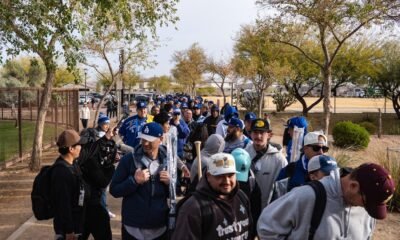baseball
MLB’s Automated Ball-Strike System Shines in Cactus and Grapefruit Leagues

Major League Baseball (MLB), the nation’s oldest sports league, is renowned for its rich traditions yet often struggles with change. While fans joyfully sing “Take Me Out to the Ball Game” and eagerly watch ceremonial first pitches, the league has historically resisted rules evolution. As other sports like football and basketball surged in popularity, baseball found itself compelled to adapt.
In recent years, the MLB has adopted significant rule changes aimed at enhancing the fan experience and accelerating game pace. A key venue for testing these innovations is the Arizona Fall League (AFL), a platform for top prospects to demonstrate their skills, which runs from October to November. Notably, alterations such as the introduction of the pitch clock, larger bases, limitations on mound visits, and shift bans were initially trialed in this league before being rolled out to the majors.
The Automated Ball-Strike Challenge System (ABS) will be the latest innovation tested in the AFL, following its trial periods in the minors since 2021. Starting this spring training, the ABS will be implemented across 13 venues, including five in the Cactus League and eight in the Grapefruit League, as noted by Morgan Sword, MLB’s executive vice president of baseball operations. Managers in attendance expressed a keen interest in the new system.
Ron Washington, manager of the Los Angeles Angels, remarked, “I’m interested in seeing how it works. Every kid that I’ve talked to from the minor leagues likes it.” Pitchers, catchers, and hitters are expected to engage with this challenge mechanism, having one to two seconds to initiate a review on a pitch after it has been thrown. Each team will get two challenges per game, retaining any successful calls.
Mike Shildt, the San Diego Padres manager, also showed enthusiasm: “I’m really curious about how this works into the game.” The full implementation of ABS into regular-season play is projected for 2026, with managers optimistic about its potential.
ABS utilizes Hawk-Eye technology to accurately determine strikes based on each batter’s historical data. A recent change in the Fall League has refined the strike zone, using the median stance of a player’s prior 50 plate appearances, further substantiating the system’s legitimacy.
Feedback from AFL players has been largely supportive. Chase DeLauter, a ranked prospect, commented, “It adds an exciting element that can change significant game situations.” The overarching aim of ABS is to allow teams to challenge potentially flawed umpire calls, enhancing fairness in gameplay.
Challenges surrounding the definition of check swings could soon be addressed, thanks to the same technology used for ABS. Players could verify whether their swing exceeded a 45-degree angle, an often contentious ruling. The prospect of eliminating ambiguity in calls, particularly one as contentious as the check swing, is welcomed by many.
While managers and players generally favor the limited challenge system over full ABS, opinions remain divided. Cubs catcher Moises Ballesteros expressed, “I don’t think it’d work if you can challenge every single pitch. Two or three challenges per game is a good experience.” This echoes the feeling that human umpires, integral to the game, should maintain their roles, even as technology expands its footprint.
Previous rule changes from the AFL, such as increased base sizes and new pickoff rules, have also demonstrated noticeable impacts. The adjustment to base dimensions aimed to reduce player collisions and has successfully encouraged more stolen bases. With MLB recording its highest number of stolen bases since 1915, the emphasis on player safety and gameplay speed is evident.
Significantly, the pitch clock introduced a transformative shift in gameplay duration. Following its implementation, the average game length has dropped by 28 minutes to just under two hours and 40 minutes. This streamlining has correlated with increased attendance, rising above 71 million for the first time since 2017.
Such advancements manifest not only in attendance but also in viewership metrics, as seen in the recent World Series. The 2024 matchup featuring the Dodgers and the Yankees averaged 15.8 million viewers, showing baseball’s increasing appeal amidst its competitive landscape.
Modern rule adaptations continue to draw on technological advancements, with the priority focused on accuracy and fairness. Torey Lovullo, manager of the Arizona Diamondbacks, summarized the sentiment: “Get the plays right, and move the game forward.” With the AFL serving as a testing ground for promising changes, MLB’s future appears vibrant and full of potential.
















